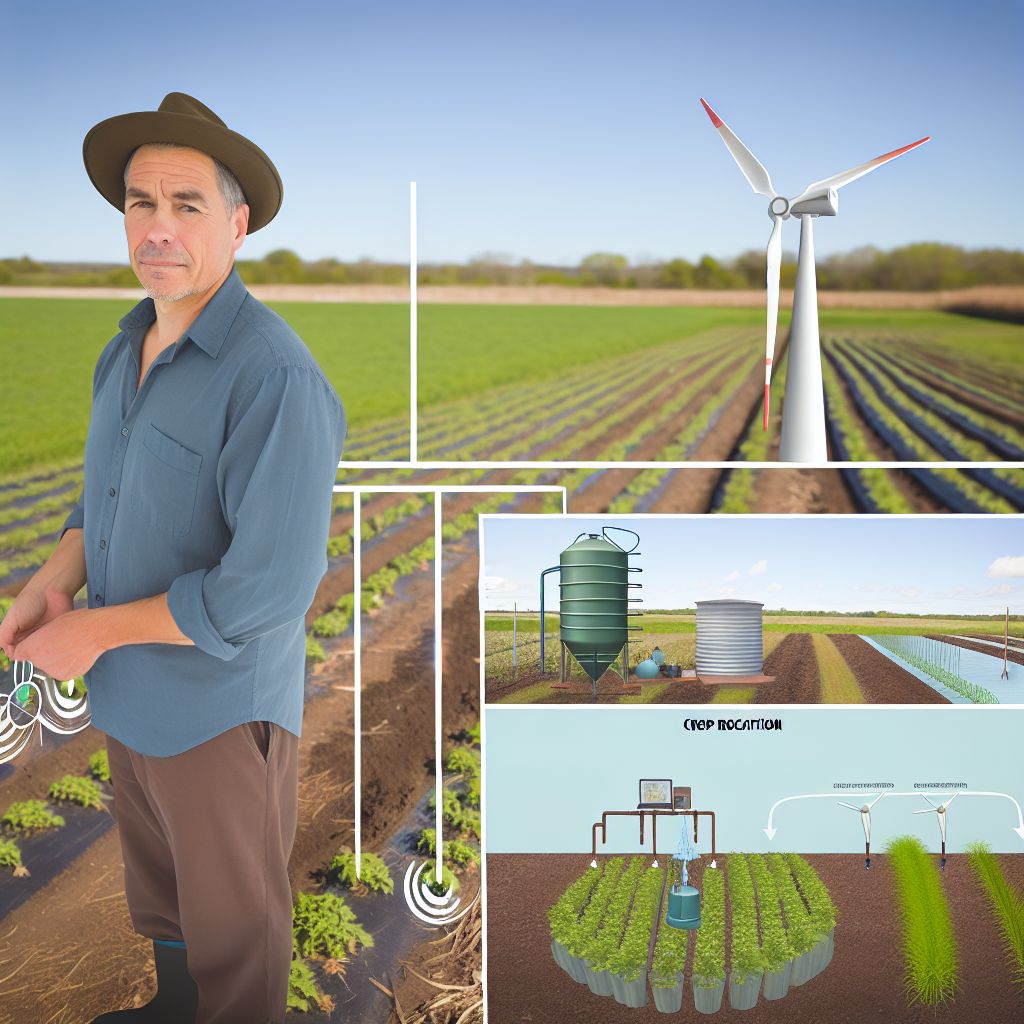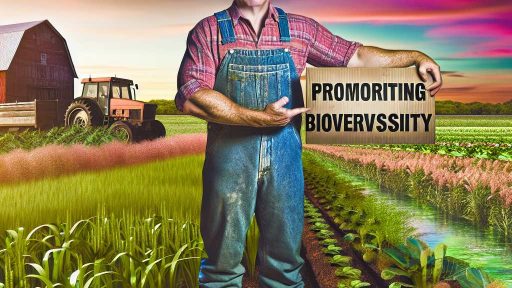Introduction to Sustainable Farming and Its Importance
Defining Sustainable Farming
Sustainable farming focuses on environmentally friendly practices.
It integrates ecological principles with agricultural production.
This approach aims to benefit both the environment and farmers.
The Need for Sustainable Practices
Modern agriculture faces significant challenges.
These include soil degradation, water scarcity, and climate change.
Adopting sustainable practices addresses these growing concerns.
Enhancing Food Security
Sustainable farming plays a crucial role in food security.
It helps produce sufficient food for a growing population.
This approach also reduces the reliance on harmful chemicals.
Economic Benefits
Sustainable practices can lead to higher long-term profitability.
Farmers can reduce input costs through efficient resource use.
Additionally, sustainability can open markets for organic products.
Community and Social Impact
Sustainable farming fosters community well-being.
It promotes local economies and strengthens food systems.
Furthermore, it encourages social equity in agriculture.
Transform Your Agribusiness
Unlock your farm's potential with expert advice tailored to your needs. Get actionable steps that drive real results.
Get StartedEmerging Technologies in Sustainable Agriculture
Precision Agriculture
Precision agriculture uses advanced technologies to optimize farming practices.
This approach relies on data collection and analysis to improve crop yields.
Farmers utilize GPS mapping to monitor and manage their fields accurately.
Additionally, drones survey farmland for identifying plant health and moisture levels.
Such technologies allow for targeted interventions, reducing waste significantly.
Biotechnology Advances
Biotechnology continues to transform sustainable agriculture practices.
Genetically engineered crops offer enhanced resistance to pests and diseases.
These crops also require fewer chemical inputs, minimizing environmental impacts.
Furthermore, biotechnology increases nutritional value in food crops.
As a result, it addresses food security while maintaining soil health.
Regenerative Agriculture Techniques
Regenerative agriculture focuses on restoring ecosystem health through intuitive practices.
Crop rotation, cover cropping, and no-till farming enhance biodiversity.
These methods build healthier soils, which retain water and nutrients better.
Moreover, regenerative techniques sequester carbon, helping mitigate climate change.
Farmers increasingly adopt these practices for long-term sustainability.
Agroecological Approaches
Agroecology integrates ecological principles into agricultural systems.
This method emphasizes the importance of local resources and biodiversity.
It encourages diverse cropping systems to enhance resilience against pests.
Additionally, agroecological practices improve soil health through organic farming.
Ultimately, this approach supports sustainable livelihoods for farming communities.
Smart Irrigation Systems
Smart irrigation technologies optimize water use in agriculture.
These systems utilize sensors to determine soil moisture levels.
This approach reduces water waste while ensuring adequate crop hydration.
Additionally, automated irrigation minimizes labor costs for farmers.
Showcase Your Farming Business
Publish your professional farming services profile on our blog for a one-time fee of $200 and reach a dedicated audience of farmers and agribusiness owners.
Publish Your ProfileSuch innovations promote efficient resource use in water-scarce regions.
Vertical Farming Developments
Vertical farming represents a revolutionary approach to crop production.
This method leverages controlled environments in urban settings.
By stacking crops vertically, farmers maximize space and reduce land use.
Moreover, vertical farms utilize hydroponics and aeroponics for growth.
These systems require less water and eliminate soil-related diseases.
Precision Farming: Enhancing Crop Yields through Data-Driven Decisions
Introduction to Precision Farming
Precision farming revolutionizes traditional agricultural practices.
This innovative approach uses technology to optimize field variability.
Farmers can now make data-driven decisions for better outcomes.
Benefits of Precision Farming
Precision farming increases crop yields significantly.
It minimizes resource waste, leading to cost savings.
Moreover, precise applications of water and fertilizers enhance sustainability.
Technologies Driving Precision Agriculture
- Drones and aerial imagery provide detailed crop monitoring.
- Soil sensors offer real-time data on soil health.
- GPS technology enables accurate field mapping and planning.
- Data analytics helps in making informed decisions.
Implementing Precision Farming Techniques
Farmers must first assess their current practices.
Next, they can invest in appropriate precision farming tools.
Training and education on technology use are essential.
Additionally, creating a plan for data management is vital.
Challenges of Precision Farming
Not all farmers have access to advanced technology.
Initial investment costs can be a barrier for many.
Furthermore, rural internet connectivity remains an issue in some areas.
Future of Precision Farming
The future looks promising for precision agriculture.
Emerging technologies continue to lower costs and increase efficiency.
As more farmers embrace this approach, global food security improves.
Ultimately, precision farming will lead to sustainable growth.
Learn More: Integrating Livestock to Enhance Farm Productivity
Agroecology: Integrating Biodiversity for Ecosystem Resilience
Understanding Agroecology
Agroecology focuses on sustainable agricultural practices.
It emphasizes the integration of ecological principles into farming.
This method enhances productivity while preserving natural resources.
The Role of Biodiversity
Biodiversity enriches agroecosystems in various ways.
It promotes soil health, pest control, and crop resilience.
Diverse plant and animal species interact synergistically.
Additionally, this interaction helps stabilize ecosystems.
Practices to Enhance Biodiversity
Farmers can adopt several practices to boost biodiversity.
- Implement crop rotation to diversify plant species.
- Utilize cover crops to improve soil health.
- Create wildlife habitats to encourage beneficial insects.
Each of these strategies contributes to a more resilient farming system.
Benefits of Integrating Biodiversity
Integrating biodiversity offers numerous advantages for farmers.
It leads to higher yields and better resilience to climate change.
Moreover, it reduces reliance on chemical inputs.
This approach also enhances food security in local communities.
Real-World Examples
Many farmers around the world successfully implement agroecological practices.
For instance, La Via Campesina promotes agroecology as a solution.
Similarly, the Rodale Institute demonstrates biodiversity benefits in organic farming.
Showcase Your Farming Business
Publish your professional farming services profile on our blog for a one-time fee of $200 and reach a dedicated audience of farmers and agribusiness owners.
Publish Your ProfileThese examples showcase the effectiveness of biodiversity integration.
Delve into the Subject: Financing Options To Expand And Sustain Your Farm Business
Vertical Farming: Maximizing Space Efficiency in Urban Areas
Introduction to Vertical Farming
Vertical farming represents a revolutionary shift in agricultural methods.
This technique utilizes vertical space to grow crops in urban environments.
Moreover, it offers a sustainable solution to rising food demand.
Benefits of Vertical Farming
One significant advantage is the reduction of water usage.
These systems often use up to 90% less water than traditional farming.
Additionally, vertical farms can be located closer to consumers.
This proximity reduces transportation costs and emissions.
Furthermore, they minimize the need for pesticides and fertilizers.
Technological Innovations Driving Vertical Farming
Modern vertical farms now incorporate advanced technologies.
Hydroponics and aeroponics are common methods used.
These methods allow plants to grow without soil, using nutrient-rich water instead.
LED lighting systems optimize growth conditions for different plants.
Automation and AI also play crucial roles in monitoring plant health.
Challenges Faced in Vertical Farming
Despite its benefits, vertical farming also faces challenges.
One key issue is the high energy consumption associated with lighting.
Moreover, startup costs for vertical farms can be substantial.
Additionally, growing a diverse range of crops is still a complex task.
Success Stories in Urban Vertical Farming
Several cities have embraced vertical farming successfully.
For instance, New York City hosts several thriving vertical farms.
One notable example is Bowery Farming, which utilizes advanced technologies.
Another example is AeroFarms, known for its innovative aeroponic systems.
These farms help address food insecurity in urban neighborhoods.
The Future of Vertical Farming
The potential for vertical farming remains immense.
As technology advances, energy efficiency is expected to improve.
Furthermore, urban planning may increasingly incorporate vertical farms.
Vertical farming paves the way for sustainable urban agriculture.
Gain More Insights: Essential Insurance Policies for Modern Farmers
Hydroponics and Aquaponics: Soil-less Cultivation Methods
Introduction to Soil-less Cultivation
Hydroponics and aquaponics are innovative farming techniques.
They allow for cultivation without soil.
This method uses nutrient-rich water solutions for plant growth.
By minimizing soil use, these systems enhance sustainability.
Moreover, they increase food production efficiency.
Understanding Hydroponics
Hydroponics involves growing plants in nutrient solutions.
Plants derive all necessary nutrients directly from the water.
This method can be applied in various systems like NFT and DWC.
Nutrient Film Technique (NFT) allows a thin film of nutrients to flow over roots.
Deep Water Culture (DWC) suspends roots in a nutrient-rich aerated solution.
Benefits of Hydroponics
- Fast growth rates due to direct nutrient access.
- Reduced water usage compared to traditional farming methods.
- Less space required for cultivation.
- Fewer pests and diseases commonly found in soil.
Exploring Aquaponics
Aquaponics combines aquaculture with hydroponics.
Showcase Your Farming Business
Publish your professional farming services profile on our blog for a one-time fee of $200 and reach a dedicated audience of farmers and agribusiness owners.
Publish Your ProfileIt creates a symbiotic environment for plants and fish.
Fish waste provides essential nutrients for the plants.
In turn, plants help filter and clean the water for the fish.
Benefits of Aquaponics
- Minimal waste production enhances sustainability.
- It offers both plant and fish harvests, maximizing output.
- Reduces the need for chemical fertilizers.
- Promotes biodiversity through integrated farming.
Challenges in Soil-less Cultivation
Despite its advantages, soil-less cultivation has challenges.
Initial setup costs can be high for hydroponics and aquaponics.
Systems require ongoing management and monitoring.
Additionally, the need for technical knowledge can be a barrier.
Future of Soil-less Cultivation
The demand for efficient food production is growing.
With population increases, soil-less farming methods will gain popularity.
They can help meet global food security challenges.
Technological advancements will continue to enhance these systems.
As a result, sustainable farming practices will become even more effective.
Delve into the Subject: Financial Planning for Successful Diversified Agribusinesses

Cover Cropping and Crop Rotation: Enhancing Soil Health
Benefits of Cover Cropping
Cover cropping plays a vital role in sustainable farming.
These crops protect the soil from erosion during off-seasons.
They also improve soil structure and fertility over time.
Additionally, cover crops reduce weed growth effectively.
Farmers can choose legumes as cover crops to fix nitrogen in the soil.
Common options include clover, vetch, and rye.
These plants contribute organic matter when decomposed.
As a result, they enhance soil health significantly.
Advantages of Crop Rotation
Crop rotation is another critical strategy for soil enhancement.
This practice involves alternating different crops in a sequence.
It prevents the depletion of specific nutrients in the soil.
Moreover, rotating crops disrupts pest and disease cycles.
Farmers can boost productivity by alternating deep and shallow-rooted plants.
For instance, corn and soybeans are often used together effectively.
This approach optimizes nutrient utilization and overall soil health.
Implementing Sustainable Practices
Implementing cover cropping and crop rotation requires planning.
Farmers should assess their land and climate conditions first.
Choosing the right cover crops depends on local soil types.
Additionally, examining market demands can guide crop selection.
Farmers often benefit from forming partnerships with local agricultural experts.
These experts can provide valuable insights and tailored recommendations.
Furthermore, continuous monitoring of soil health is essential.
Adapting practices based on feedback helps achieve optimal results.
Renewable Energy Sources in Farming: Reducing Carbon Footprints
Introduction to Renewable Energy in Agriculture
Renewable energy sources are transforming agriculture today.
Farmers are increasingly adopting sustainable practices.
They aim to reduce carbon footprints and improve productivity.
Types of Renewable Energy Sources
Solar energy is one of the most popular options.
Showcase Your Farming Business
Publish your professional farming services profile on our blog for a one-time fee of $200 and reach a dedicated audience of farmers and agribusiness owners.
Publish Your ProfileIt powers irrigation systems and greenhouse heating.
Wind energy also plays a vital role in farming.
Farmers use turbines to generate electricity on-site.
Moreover, bioenergy derived from organic waste is effective.
Advantages of Utilizing Renewable Energy
Using renewable energy reduces dependence on fossil fuels.
Additionally, it lowers greenhouse gas emissions significantly.
This practice enhances food security and sustainability.
Innovative Implementations in Farming
Farmers are installing solar panels on barns and fields.
Some are exploring vertical farming with integrated solar systems.
These innovations create energy-efficient environments.
Additionally, energy storage technologies improve reliability.
Success Stories from the Field
Many farmers report increased profitability with renewables.
Maria Sanchez, a strawberry farmer, uses solar energy extensively.
She notes a 30% reduction in operational costs.
Similarly, Green Valley Farms installed wind turbines.
They now provide energy for their processing facilities.
Challenges and Considerations
Despite benefits, there are challenges in implementation.
High initial costs can deter some farmers.
Additionally, technology maintenance requires expertise.
However, government incentives can alleviate financial burdens.
The Future of Renewable Energy in Farming
As technology advances, renewable energy will become more accessible.
Farmers will increasingly integrate these energy sources.
The shift towards sustainability is a critical global objective.
Ultimately, renewable energy enhances both productivity and environmental health.
Implementing Sustainable Pest Management Techniques
Introduction to Sustainable Pest Management
Sustainable pest management focuses on environmentally friendly methods.
This approach aims to control pests while minimizing harm to ecosystems.
Farmers adopt various strategies to maintain crop health effectively.
Furthermore, sustainable methods reduce reliance on chemical pesticides.
Utilizing Biological Controls
Biological control involves using natural enemies of pests.
Predators can keep pest populations in check naturally.
Farmers may introduce beneficial insects, like ladybugs or lacewings.
Additionally, parasites can target specific pest species.
For instance, parasitic wasps lay eggs in pest larvae.
Crop Rotation and Diversity
Crop rotation disrupts the lifecycle of pests effectively.
Changing plant species annually reduces pest populations.
Moreover, planting diverse crops increases resilience to pests.
Diversity attracts beneficial insects, providing natural pest control.
Implementing Cultural Practices
Cultural practices can significantly reduce pest pressures.
Farmers can adjust planting schedules to avoid peak pest activity.
Maintaining healthy soil boosts plant resistance to pests.
Showcase Your Farming Business
Publish your professional farming services profile on our blog for a one-time fee of $200 and reach a dedicated audience of farmers and agribusiness owners.
Publish Your ProfileAdditionally, proper irrigation can minimize diseases linked to pests.
Monitoring and Data Collection
Effective pest management requires accurate monitoring techniques.
Farmers should regularly inspect crops for signs of pests.
Using traps can provide valuable data on pest populations.
This information helps inform management decisions.
Incorporating Integrated Pest Management (IPM)
IPM combines multiple pest control methods for effectiveness.
This strategy emphasizes prevention and long-term management.
Farmers assess pest damage and economic thresholds before acting.
Reducing pesticide use leads to healthier ecosystems.
Community Collaboration
Farmers benefit from sharing knowledge and resources within communities.
Working together enhances pest management strategies.
Local organizations can provide guidance on sustainable practices.
Furthermore, community workshops encourage learning and sharing.
Case Studies: Successful Sustainable Farming Innovations Worldwide
Innovative Practices in Denmark
Agricultural producers in Denmark have adopted integrated pest management (IPM) techniques.
This method reduces the use of chemical pesticides significantly.
Farmers monitor pest levels to determine when to apply treatments.
As a result, this practice enhances ecological balance while improving crop yields.
Vertical Farming in Singapore
In Singapore, vertical farming techniques are gaining traction.
Urban farms utilize limited space effectively to cultivate crops vertically.
This method allows for year-round production despite geographical limitations.
Furthermore, it significantly reduces transportation emissions by sourcing food locally.
Agroforestry in Brazil
Brazillian farmers are integrating agroforestry into their practices.
They plant trees alongside crops to increase biodiversity.
This strategy enhances soil health and prevents erosion.
Consequently, farmers experience improved resilience against climate change.
Organic Farming in California
California leads the USA in organic farming initiatives.
Farmers use natural fertilizers and pest control methods.
These practices yield healthier crops and improve soil conditions.
This approach aligns with consumer preferences for healthier food options.
Precision Agriculture in Australia
Australian farmers employ precision agriculture techniques to boost efficiency.
They use technology to analyze field conditions and manage resources effectively.
This results in reduced waste and optimized production practices.
Moreover, it minimizes environmental impacts while enhancing productivity.
Community Supported Agriculture in the UK
Community supported agriculture (CSA) has gained popularity in the UK.
This model connects consumers directly with local farmers.
It provides farmers with financial security and reduces food waste.
Participants receive fresh produce while supporting sustainable agriculture.




